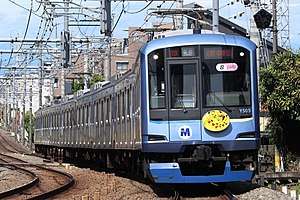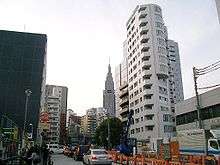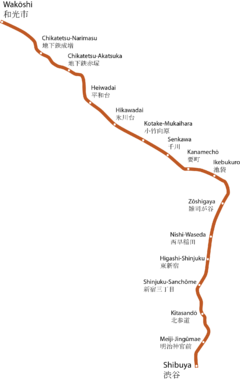Tokyo Metro Fukutoshin Line
The Tokyo Metro Fukutoshin Line (東京メトロ副都心線, Tōkyō Metoro Fukutoshin-sen), formally the No. 13 Fukutoshin Line (13号線副都心線, Jūsangō-sen Fukutoshin-sen), is a subway line operated by Tokyo Metro in west-central Tokyo and Wako, Saitama, Japan. The newest line in the Tokyo subway network, it opened in stages between 1994 and 2008.[2] On average, the Fukutoshin line carries 362,654 passengers daily in 2017,[1] the lowest of all Tokyo Metro lines and roughly one third of its sister Tokyo Metro Yūrakuchō Line (1,124,478).
| Tokyo Metro Fukutoshin Line | |||
|---|---|---|---|
 A line up of Fukutoshin Line rolling stock in June 2009 | |||
| Overview | |||
| Other name(s) | No. 13 Fukutoshin Line | ||
| Native name | 東京メトロ副都心線 | ||
| Type | Rapid transit | ||
| Locale | Tokyo | ||
| Termini | Wakōshi Shibuya | ||
| Stations | 16 | ||
| Daily ridership | 363,654[1] | ||
| Operation | |||
| Opened | December 7, 1994 (as Yūrakuchō New Line) June 14, 2008 (as Fukutoshin Line) | ||
| Owner | Tokyo Metro | ||
| Depot(s) | Wakō | ||
| Rolling stock | Tokyo Metro 7000 series Tokyo Metro 10000 series Seibu 6000 series Seibu 6050 series Seibu 40000 series Tobu 9000 series Tobu 9050 series Tobu 50070 series Tokyu 5050 series Tokyu 4000 series | ||
| Technical | |||
| Line length | 20.2 km (12.6 mi) | ||
| Track gauge | 1,067 mm (3 ft 6 in) | ||
| Electrification | 1,500 V DC overhead catenary | ||
| Operating speed | 80 km/h (50 mph) | ||
| |||
Overview
The Fukutoshin Line is the deepest metro line in Tokyo, with an average depth of 27 meters.[3] At Shinjuku-sanchōme Station, the line passes under the Marunouchi and above the Shinjuku lines at a depth of 15 meters, with a gap of only 11 centimeters to the Shinjuku Line tunnel.[3] The deepest section is at the immediately adjacent Higashi-Shinjuku Station, where the line goes down to 35 meters, partly due to an underground space reservation for a possible future extension of the Jōetsu Shinkansen to Shinjuku.[3]
It is the second Tokyo Metro line to feature express services, after the Tōzai Line; however, unlike the Tozai Line (where rapid services are only offered on the Tōyōchō – Nishi-Funabashi section), the Fukutoshin Line offers express services throughout the line, a first for Tokyo Metro. Express trains pass local trains at Higashi-Shinjuku, where additional tracks are installed for this purpose. Local trains stop at all stations.
When first opened, the line operated through services to Kawagoeshi Station on the Tobu Tojo Line and Hannō Station on the Seibu Ikebukuro Line. From 16 March 2013, the Tōkyū Tōyoko Line moved to share the line's Shibuya terminus, and since then through services have operated onto the Minatomirai Line via the Tōyoko Line, terminating at Motomachi-Chūkagai Station in Yokohama.[4] This is a rare instance of a Tokyo Metro train operating on four companies' tracks.[5]
Between Kotake-Mukaihara Station and Shibuya Station the Fukutoshin Line operates as a one-man operation subway line where chest-high platform edge doors are installed on the station platforms to aid the drivers.[6]
Like most Tokyo Metro lines, the first carriage of the Fukutoshin Line is designated a "women-only car" before and during the morning rush hour. During these hours only women, children of elementary school age or younger and physically disabled passengers (and their carers) may board the first carriage.[7]
Station list
- Express and commuter express trains stop at stations marked "●" and pass those marked "|".
- Local trains stop at all stations.
| No. | Station | Japanese | Distance (km) | Comm. Exp. |
Express F Liner |
S-Train | Transfers | Location | ||
|---|---|---|---|---|---|---|---|---|---|---|
| Between stations |
From F-01 | |||||||||
| ↑ Through-service to/from Ogawamachi via the Tobu Tojo Line ↑ | ||||||||||
| F01 | Wakōshi | 和光市[* 1] | – | 0.0 | ● | ● | Seibu Yūrakuchō Line |
|
Wakō, Saitama | |
| F02 | Chikatetsu-narimasu | 地下鉄成増 | 2.2 | 2.2 | ● | | |
|
Itabashi | Tokyo | |
| F03 | Chikatetsu-akatsuka | 地下鉄赤塚 | 1.4 | 3.6 | ● | | |
|
Nerima | ||
| F04 | Heiwadai | 平和台 | 1.8 | 5.4 | ● | | | Y Tokyo Metro Yurakucho Line (Y-04) (same tracks) | |||
| F05 | Hikawadai | 氷川台 | 1.4 | 6.8 | ● | | | Y Tokyo Metro Yurakucho Line (Y-05) (same tracks) | |||
| F06 | Kotake-mukaihara | 小竹向原[* 2] | 1.5 | 8.3 | ● | ● | | |
| ||
| F07 | Senkawa | 千川 | 1.1 | 9.4 | | | | | | | Y Tokyo Metro Yurakucho Line (Y-07) | Toshima | |
| F08 | Kanamechō | 要町 | 1.0 | 10.4 | | | | | | | Y Tokyo Metro Yurakucho Line (Y-08) | ||
| F09 | Ikebukuro | 池袋 | 0.9 | 11.3 | ● | ● | [* 3] |
| ||
| F10 | Zōshigaya | 雑司が谷 | 1.8 | 13.1 | | | | | | | Toden Arakawa Line (Kishibojimmae) | ||
| F11 | Nishi-waseda | 西早稲田 | 1.5 | 14.6 | | | | | | | Shinjuku | ||
| F12 | Higashi-shinjuku | 東新宿 | 0.9 | 15.5 | | | | | | | E Toei Oedo Line (E-02) | ||
| F13 | Shinjuku-sanchome | 新宿三丁目 | 1.1 | 16.6 | ● | ● | ● |
| ||
| F14 | Kita-sandō | 北参道 | 1.4 | 18.0 | | | | | | | Shibuya | ||
| F15 | Meiji-jingūmae (Harajuku) | 明治神宮前 | 1.2 | 19.2 | | | ● | | |
| ||
| F16 | Shibuya | 渋谷[* 4] | 1.0 | 20.2 | ● | ● | ● |
| ||
| ↓ Through-service to/from to Motomachi-Chūkagai via the Tokyu Toyoko Line and Minatomirai Line ↓ | ||||||||||
- Wakoshi is shared by both Tobu and Tokyo Metro; Tobu manages the station.
- Kotake-mukaihara is shared by both Seibu Railway and Tokyo Metro; Tokyo Metro manages the station.
- Weekends and national holidays for alighting passengers only.
- Shibuya is shared by both Tokyu Corporation and Tokyo Metro; Tokyu Corporation manages the station.
Rolling stock
Tokyo Metro
- 7000 series 8-car and 10-car trains
- 10000 series 10-car trains
 Tokyo Metro 7000 series
Tokyo Metro 7000 series Tokyo Metro 10000 series
Tokyo Metro 10000 series
Other operators
- Seibu 6000 series 10-car trains
- Seibu 6050 series 10-car trains
- Seibu 40000 series 10-car trains (since 25 March 2017)
- Tobu 9000 series 10-car trains
- Tobu 9050 series 10-car trains
- Tobu 50070 series 10-car trains
- Tokyu 5050 series 8-car trains
- Tokyu 4000 series 10-car trains (since 10 September 2012)
- Yokohama Minatomirai Railway Y500 series 8-car trains (a Tokyu 5000 series variant)
- Seibu 6000 series
 Yokohama Minatomirai Railway Y500 series
Yokohama Minatomirai Railway Y500 series
History

Fukutoshin is Japanese for "secondary city center", and the Fukutoshin Line connects three of Tokyo's secondary city centers: Ikebukuro, Shinjuku and Shibuya. Prior to its opening, only JR East had rail service between the three (on the Yamanote Line, the Saikyō Line and the Shōnan-Shinjuku Line). The new line was conceived to relieve congestion along this busy corridor, and to provide convenient through service between the northwest, the southwest and the central part of Tokyo served by the Yamanote Line.
The line was initially planned in 1972 as a run from Shiki, Saitama to Shinjuku, with the possibility of further extension to Shibuya, Shinagawa and Haneda Airport. In 1985, a second Ministry of Transportation committee proposed that the line terminate at Shibuya. Part of the northern end of the original plan line became unnecessary following improvements to the Tobu Tojo Line and the beginning of through service from the Yurakucho Line.
The original plan for the Fukutoshin Line only contained fifteen stations, however in May 1999 a plan for an additional station "Shin-Sendagaya" (later renamed Kitasandō) between Shinjuku-sanchōme and Meiji-Jingūmae was included due to an increase in demand from the area.[8]
A 3.2 km segment from Kotake-Mukaihara to Ikebukuro, running parallel to the Yurakucho Line on separate tracks began operation in 1994. This segment was initially known as the Yūrakuchō New Line (有楽町新線, Yūrakuchō Shin-sen), and was operated with no intermediate stops.
The newest segment connecting the districts of Shinjuku and Shibuya via Zōshigaya, Shinjuku-sanchōme, and Meiji-Jingūmae (‘Harajuku’) opened for service on 14 June 2008, officially completing the Fukutoshin Line. Service to the Senkawa and Kanamechō stations, which had been bypassed by the Yūrakuchō New Line, also started on the same day.
Technical problems resulted in delays of up to 30 minutes during the Fukutoshin Line's first few days of operation.[9]
On 6 March 2010, express services began stopping at Meiji-Jingūmae on weekends and holidays.[10]
From 10 September 2012, 10-car 5050-4000 series sets entered revenue service on the Tokyo Metro Fukutoshin Line, with inter-running through to the Seibu Ikebukuro Line (via Seibu Yurakucho Line) and Tobu Tojo Line.[11]
See also
References
- Japan Railfan Magazine July 2008 issue
- 平成20年6月14日(土)副都心線開業 (in Japanese)
- Tokyo Metro station ridership in 2017 Train Media (sourced from Tokyo Metro) Retrieved July 23, 2018.
- "Archived copy". Archived from the original on 2012-07-10. Retrieved 2008-06-14.CS1 maint: archived copy as title (link)
- "東京メトロ・副都心線 14日開業". MONO好き親父の一輪車乗りの独り言. Retrieved 3 March 2019.
- 東武東上線がより便利に! 自由が丘、横浜、元町・中華街方面とつながります! [The Tojo Tobu Line will be even more convenient! Linked with Jiyugaoka, Yokohama, and Motomachi-Chukagai] (pdf). Tobu News (in Japanese). Tobu Railway. 24 July 2012. Retrieved 24 July 2012.
- "Rail linkup to ease metro commute". The Japan Times. Japan: The Japan Times Limited. 24 January 2013. Retrieved 24 January 2013.
- 14 May 2008. Accessed 1 August 2013.
- "女性専用車|東京メトロ". www.TokyoMetro.jp. Retrieved 3 March 2019.
- より便利な地下鉄を目指して 20 May 1999. Accessed 1 August 2013.
- http://mdn.mainichi.jp/national/archive/news/2008/06/17/20080617p2a00m0na006000c.html%5B%5D
- 3月6日(土)有楽町線・副都心線のダイヤ改正 3 February 2010. Accessed 8 March 2010.
- 東急5050系が西武鉄道池袋線で営業運転開始 [Tokyu 5050 series enters service on the Seibu Ikebukuro Line]. RM News (in Japanese). Japan: Neko Publishing. 10 September 2012. Retrieved 10 September 2012.
External links
| Wikimedia Commons has media related to Tokyo Metro Fukutoshin Line. |
- Fukutoshin Line (Tokyo Metro) (in English)
